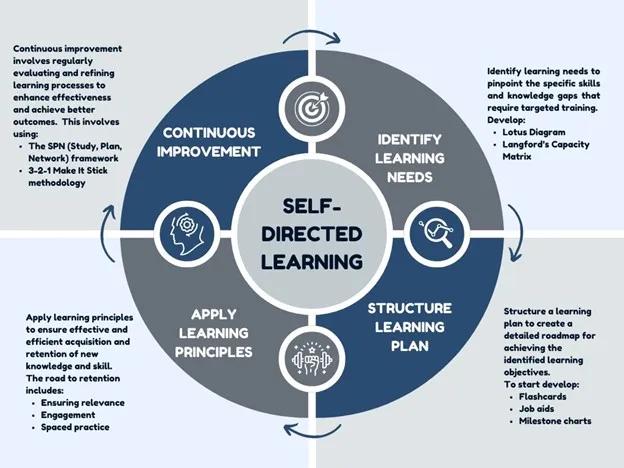ATD Blog
Lab and Conference and Blog, Oh My!
It has been five months since the 2024 ATD Spring Lab (SL), and I am evolving in my self-directed learning path.
Tue Aug 13 2024

The Lab
It has been five months since the 2024 ATD Spring Lab (SL), and I am evolving in my self-directed learning path. Initiated in this lab were the valuable teachings of Dr. Catherine Lombardozzi. Through the Learning About Learning – An Adventure of Discovery, I was introduced to valuable tools such as: how to identify a learning need (Orientating), how to use the Lotus Diagram to sort through my guiding questions, and Langford’s Capacity Matrix for charting my progress (Wayfinding). The tools and methodologies used along with Dr. Lombardozzi’s workbook Charting Your Course (CYC) elevated my knowledge and understanding through my Journeying Phase with internal and external work resources, introducing me to a framework of constructive learning that would also allow me to share my experience with others.
How I Learn
Through the SL, I was further enlightened with Dana Alan Koch’s Principles of Learning Durability, which have become an integral part of my ongoing educational journey. I incorporated these eight principles into my curriculum design techniques and keep them handy for continuous reference. The categories along with single areas of concentration have significantly supported my self-paced growth.
While these principles were incredibly helpful, I realized to truly improve my retention, I needed to Study, Practice what was learned, and Network for reinforcement (SPN). Incorporating these steps helped make learning “stickier.” To enhance my SPN strategy, I aligned it with Koch’s principles, as shown in this chart:
S | Relevant: Building on my prior knowledge. Contextual: Providing the big picture helped me know what I need to tackle. Effortful: Hard is good; anything worth learning takes time. If it were easy, you would already know it! So, it is important to take the time needed to learn. |
P | Generative: Practicing the techniques allowed me to make a connection and be able to interpret what I learned to others. Reflective: This step went hand and hand with generative, because I must be able to interpret what I retrieve. Spaced Practice: To retain, cramming is never the answer; I had mini sessions to build my knowledgebase. |
N | Social: Networking to gain other perspectives. Engaging: Inspiring active participation; learn by doing. |
With knowledge gained, additional resources were added to my toolbox. This included:
Flash cards – I used my virtual skills to develop interactive cards through Articulate Rise 360 for new hire learning.
Job aids – Developing a 10 Step Infographic Chart helped me learn the primary skills needed for frontline workers and now can be used for new hires.
Milestone Charts and Checklists – Utilizing teams tasks to record steps and dates to complete my goal also allows my team to follow along as I achieve my milestones.
Reviewing and Reflecting – This helps as I study, to ensure I am interpreting the material and can recite in my own words.
Keeping a Virtual Notebook – In OneNote, I keep my portfolio of hits and misses as I guide my learning.
Stuck in the Waypoint
I must admit while the journey propelled my experience, my “stuck” came when being introduced to different learning methodologies. I wanted to concur them all! This is when I had to step away from my work and consider how I could be my own solution. Using the framework of SPN durable principles is what centered me. Comprehension through my interpretation and working with people are what reignited my path. My takeaways are to constantly learn by having a growth mindset increased by networking whether within your own work group or outside of it. In this aspect, being stuck is fine if you are continuing to grow and research to get back on track and regain momentum.
ATD24
It’s conference time! With my newfound knowledge, I wanted to engage in courses that would move me into my Waypoint phase. I went in with notebooks ready and pencils sharpened to come out just that much more overwhelmed. That is until I signed up for a session that used the Principles of Learning Durability in a way that further resonated with me. The session was: 3-2-1 Make It Stick. The after affect allowed me to capture information from all the sessions I attended by answering the questions below:
What are the three main ideas related to this topic?
What are two connections to other topics you are familiar with?
What is one question you have about this topic or experience that you want to dive into deeper?
Mind blowing right? This proved ideal for detail gathering and retaining. I now turned these questions into areas that could add weight to my growth and capitalize on techniques to reinforce my learning, retaining, and passing along my insights when networking. Allowing me to grow with my team, also makes me a better learner.
Another useful session was: 20 Ways to Use Microlearning – and 20 Design Tips. Now, you may be asking, “How can a design course help me in my self-directed learning?” Simple, when designing curriculum for others, we often put ourselves in the learners’ shoes to see if content is hitting the right note. So, why not twist information given to fit the need of the learner (you)?
Points gained from this course were to:
Be Specific
Be Brief
Be Engaging
Be Performance Focused
Focus on the Learning Example
Timeframes are also conducive to learning. Whether it be dedicating time to prepare or allotting time for support. Time matters when it comes to retention. So, I honed into this format:
Preparation – 10 minutes
Standalone – 4 minutes
Follow-up – 1 minute
Support – 15 seconds
By keeping time at the forefront of development and self-learning, I stay mindful of devoting the appropriate amount of continuance when designing or developing my own method of learning.
What Changed
Combining my learnings from the lab and conference, I was able to turn these nuggets into my learning path, and the SPN that started it all is now a piece of my self-directed learning cycle. My draft of a formal learning plan that relates to being a self-directed learner is summarized in four steps:
Identify Learning Needs
Structure Learning Plan
Apply Learning Principles
Continuous Improvement

Through this structured approach, I have developed a visual cycle for self-directed learning. This visual representation encapsulates my learning process and highlights the importance of intentional growth.
My transitional advancement has enabled me to share my experiences publicly during the Forum’s lab and through this blog. The insights I have gained are now essential components of my retention checklist. This includes:
Engaging in intentional learning from peers through weekly discussions involving articles, podcasts, or YouTube videos
Receiving
project support from my director during one-on-one sessions and leadership meetings, which nurture my skillset
Consulting with my ATD network via TD magazine, TD.org, the ATD Forum sessions, and by connecting with other Forum SL attendees including those in my cohort to explore new techniques
By incorporating these elements, I will continue to get better at getting better as a self-directed learner, constantly seeking opportunities for growth and improvement.
